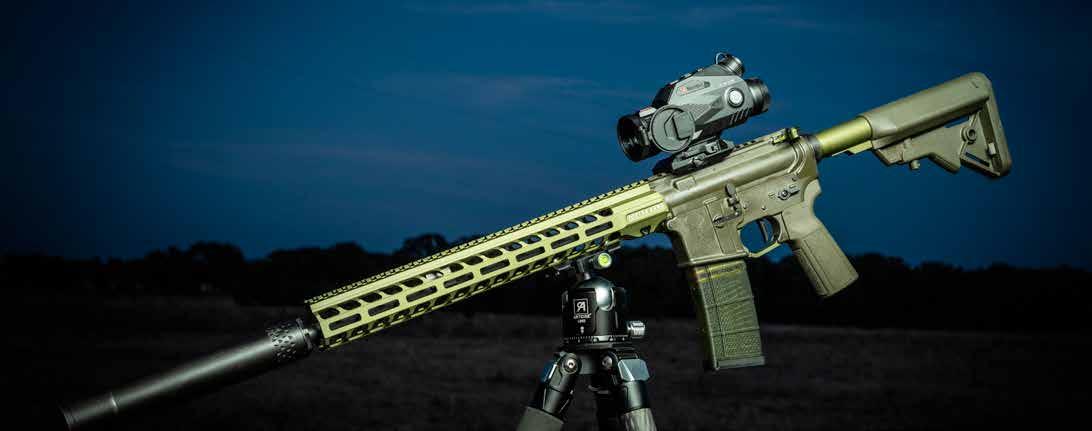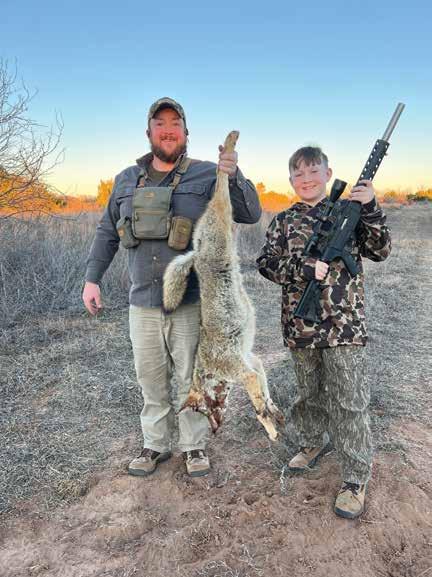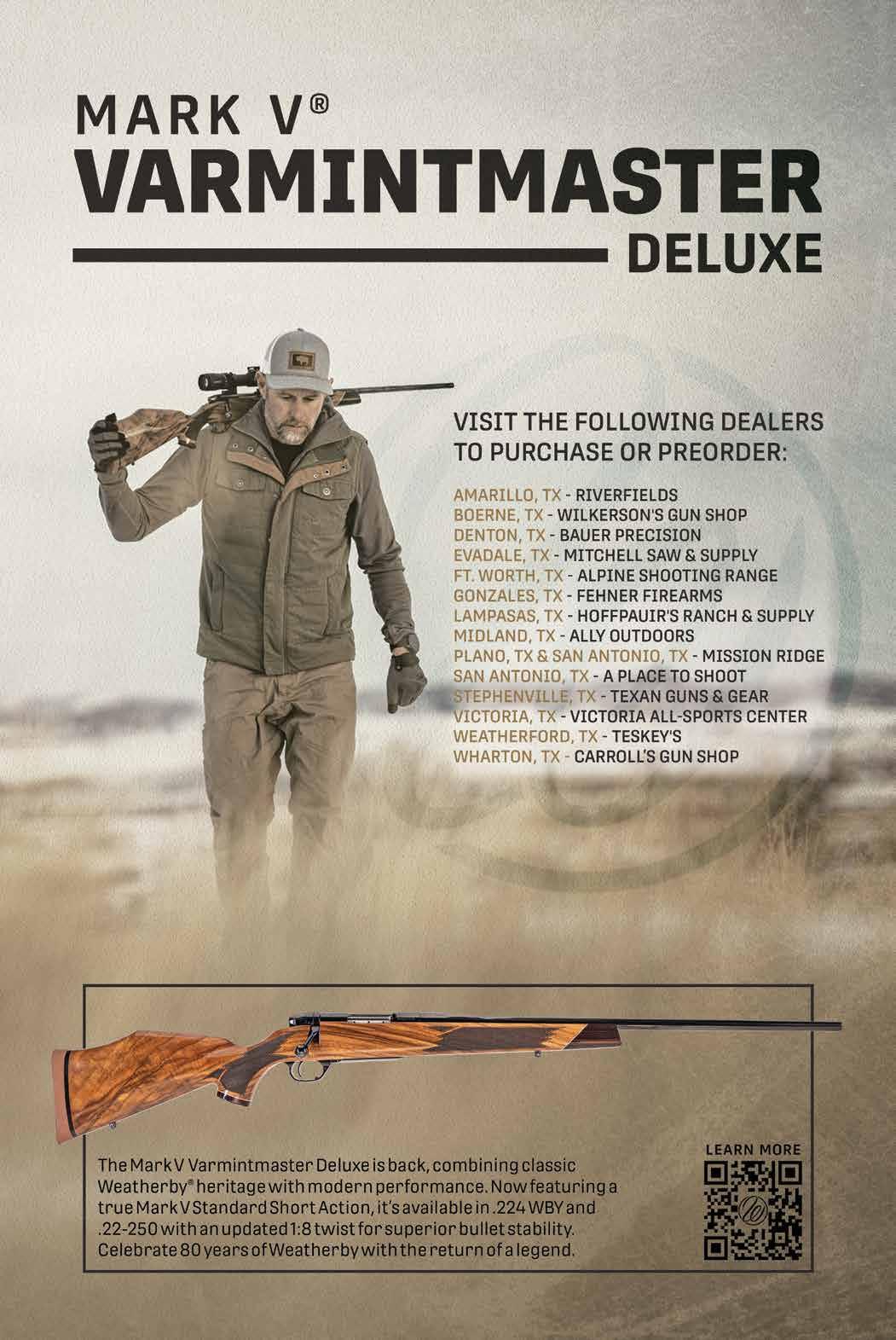






WHATEVER YOUR ADVENTURE IS, WE'VE GOT YOU COVERED.






By Mike Bodenchuk
For Lone Star outdoor newS
While February marks the end of conventional hunting seasons, it also marks the beginning of the breeding season for predators. Notably, gray fox, coyotes and bobcats are on the prowl for mates, and the “bobcat rut” may be the best time to target these trophy predators.
Unlike coyotes and fox, which can subsist on a wide variety of food, bobcats are obligate predators and their abundance is directly related to the number of rabbits in a given area. Bobcats are also limited by competition from coyotes, and in some cases they are limited by direct predation by coyotes. Because of this, bobcats prefer to stay in thicker cover with taller trees available for escape cover. Creek and river bottoms are the favored daytime locations for these spotted cats and predator callers should concentrate on places where the cover provides safety and rabbits for bobcats to hunt.
Bobcats hunt with their eyes, so predator callers should expect a cat to approach a call fairly well-hidden, but they will stop in a location where they can see. Daytime callers should consider using binoculars to scan the edges of brush periodically. You may be surprised to see a bobcat’s face peering out of the edge of a sendero or ranch road. Nightime callers are using thermal imaging more than spotlights, and watching the thicker brush for an advancing cat can be easier on cool February nights.
Bobcats are most prolific in South Texas, broken short grass prairies in the Panhandle and in the Trans-Pecos. Oddly, in Central Texas where sheep and goat raising requires intensive coyote control, bobcats can be locally abundant due to the lack of competition from coyotes. Wherever you find them, bobcats are often attracted to rabbit or bird distress calls. However, during the “bobcat rut” cats can be attracted to the sounds of breeding cats. E-callers with a wide variety of sounds can bring big toms running if they think an interloper is in the neighborhood.
Bobcats are classified as nongame animals in Texas, but a hunting license is required to hunt them. There is no closed season and no bag limit and you can night hunt on private land with the landowner’s permission. A trappers license is required to sell the furs and any cat offered for sale or shipped out of state must be tagged with a Convention on the International Trade of Endangered Species tag by Texas Parks and Wildlife Department.
For decades bobcat pelts brought a high price, but the market has cooled considerably and many bobcats are now finding their way to a taxidermists shop to be mounted. Check with your taxidermist and find out if he or she sends the hides out-of-state to be tanned. If so, make sure you get the trophy tagged by TPWD before dropping it off at the taxidermist’s shop.
From early February until the middle of March, bobcats will be covering ground and looking for a mate. After the rut they tend to hold up on a very small piece of ground. If you’re looking for that trophy bobcat, now is the time to get out and call up your cat.

Not all zoom methods are created equal. While magnification is essential in thermal optics, most thermal devices rely on digital zoom, which enlarges an image by cropping and resizing pixels. While this increases magnification, it also reduces image quality, making it harder to identify fine details at higher zoom levels.
The Nocpix ACE takes a different approach with “ocular zoom,” an optical magnification system that enhances the image without sacrificing resolution. Unlike digital zoom which degrades clarity, ocular zoom preserves full sensor resolution, ensuring targets remain crisp and well-defined.

As implied by the name, this optical magnification method is applied on the shooter’s end, enlarging the high-resolution display. The ACE’s ocular magnifier provides 1-3x optical magnification, delivering smooth, high-clarity zoom without pixelation. This also means that the reticle and target remain proportional, similar to a first-focal plane precision rifle scope.
What makes the ACE truly versatile is that both digital and ocular zoom can be used independently or together. Users can rely on ocular zoom for a high-resolution image, use digital zoom for quick magnification, or combine both for greater flexibility. Shooting at base magnification (1x) maintains the sensor’s full resolution while maximizing the field of view.
By offering ocular and digital zoom as separate, independent systems, the Nocpix ACE allows users to adapt their magnification to any scenario. Whether scanning a wide area, zooming in for identification, or fine-tuning a shot, the ACE ensures clarity and flexibility go hand-in-hand, delivering an unmatched thermal experience.
By Mike Bodenchuk For Lone Star outdoor newS
Researchers from the Caesar Kleberg Wildlife Research Institute are studying mountain lions along the border looking to update biological data and determine if the border wall is having an effect on lion movement.
At a wildlife research seminar at the San Antonio Livestock Show, researchers detailed the project and gave preliminary results of a study funded by the U.S. Fish and Wildlife Service.
Dr. Lisanne Petracca told the seminar audience that the FWS funded the study because of concerns about the effects of the wall, which has been completed in some of the sections of the border. Environmentalists fear that the wall could serve as a barrier to mountain lion movement, not only from the physical barrier but from the roads and lights associated with the wall.
To study the effects, the science team has already radio collared four mountain lions. The GPS collars keep track of movements hourly, but when the cats get within 1/2 mile of the wall it gets location data every 5 minutes. This allows researchers to see what effects, if any, are associated with the barrier. Along the way, they can assess mountain lion prey, determine home range sizes, get genetic info and,
by using a grid of trail cameras, estimate population size in the affected area.
As for preliminary results, thus far three of the four mountain lions have encountered the wall, and two of the three have successfully passed through the barrier. There are small openings set into the wall to allow wildlife passage and these openings all have cameras on them. The lions have yet to discover the crossings, but Dr. Petracca showed video of lions in Arizona using the crossings.
Not unexpectedly, the collared male mountain lions have large home ranges — 109,000 acres for one and 170,000 acres for the second male. The females, by contrast, have small home ranges — 11,000 acres and 22,000 acres. One of the collared females is suspected of having kittens, but these have yet to be collared.
The camera grids are still being put in place, but the cameras have already detected other lions in the area. One uncollared female has three kittens approximately 6 months old. The issue of genetic connectivity is still to be addressed, but the researchers are hoping to get genetic samples from Mexico to look at whether or not there are genetic connections across the border.
The study is scheduled to go for another year or more. In addition to Dr. Petracca, there are two graduate students and one field technician working on the project.







By Craig Nyhus Lone Star outdoor newS
For years, fur prices have been dropping. Overseas markets held them up for a while, but even that market has diminished. Gone are they days when high schoolers paid for college through trapping. Texas wildlife managers, though, know the value of decreasing predation on fawns, quail and turkey, including their eggs.
While you may not see the value of fur in the pocketbook, there are still some things you can do, while at the same time helping your wildlife numbers. Maybe it’s a bobcat vest, a coyote jacket, a raccoon hat or a display item, furmakers and taxidermists can help you create the items you and your family will enjoy for years.
If you skin and tan the hides yourself, a hanging display can bring personal “value” to a wall in your home or garage.
A check of current prices, compared with those in 2015, is below. These prices are for Texas representative animals. For example, prices for winter animals in northern states or Canada are significantly higher.
The Nevada Trappers Association’s Average Price Report showed higher prices, though, for high-quality furs. Bobcats brought an average of $546, while coyotes brought only $11.98 and gray fox $17.86. Red fox brought $16.22, and even striped skunks brought $24.18.
At an Alaskan fur auction Feb. 22, a beaver sold for $120, a silver fox brought $245, two ermine brought $135 and lynx and wolverine $500.
Current Texas fur prices Pelt



You’ve no doubt noticed that predators and game animals are often very cautious when coming to a call and often hang up at a safe distance. This is not just their wary nature, it’s also because of the limitations of your e-caller.
Ordinary e-callers produce sound recorded on equipment designed for the frequencies that humans can hear (up to 20 kHz), and peak out at 12 to 18 kHz. The revolutionary new FREQ™ Ultrasonic Game Call produces ultrasonic sound up to 50 kHz which corresponds to the range at which coyotes (44 kHz) and bobcats (64kHz) can hear. And which rabbits emit (50kHz).
FREQ™ inventor, Gary Roberson, has tested these ultrasonic game calls and the results are nothing short of astonishing.
His stand success has doubled and the responses he gets are extremely aggressive. And, he gets far fewer hang-ups and virtually never hears an alarm bark! Why? Because FREQ™ produces never-before-achieved, full spectrum sound!
This revolutionary technology did not previously exist. Roberson discovered that you cannot simply transform existing recorded call sounds into full spectrum, ultrasonic call sounds. This meant developing ultrasonic recording equipment and recording all of the needed sounds. And, then, building a speaker capable of playing ultrasonic sound. Essentially it meant totally reinventing electronic game calls. Which is exactly what Gary did!

“On a ranch where attracting coyotes had been challenging for a couple of years due to night hunting pressure, we achieved remarkable success with the FREQ. We called up 11 coyotes and killed 10, all within a 100-yard range.”




































Managing predation on livestock is somewhat of a simple formula — keep the coyotes away from the goats or sheep. But for most Texas landowners and hunters, preventing predators from eating deer fawns and turkey is a critical consideration.
Managing predation on wildlife is complex. In a recent wildlife seminar in Nashville, Tennessee, Lone Star Outdoor News contributor and wildlife biologist Mike Bodenchuk outlined predator/prey relationships and described effective predator management programs to protect big game, turkeys and quail.
In the seminar, Bodenchuk described several predator/prey relationships and noted that 18 different factors affect predation rates. When multiple predators start working on a single prey species (such as coyotes and mountain lions both killing mule deer), the impacts are cumulative or “additive predation” in biologist-speak.
One of the factors affecting predation rates is the “breeding synchrony” which addresses does being bred on their first heat cycle. If all the does are bred in a narrow window, the coyotes can’t possibly get all the fawns. But if buck:doe ratios get too low, does may not be bred until later in the year and the fawn drop is extended over two or more months, allowing the same number of coyotes to remove a bigger proportion of the fawns. Managing for a higher buck:doe ratio, Bodenchuk said something in the 30-40 bucks per 100 does will reduce predation on fawns.
However, removing coyotes after the pair bonds have been established in January, but before the female coyotes whelp in mid-April, can significantly reduce predation on newborn deer and pronghorn fawns.
“As an easy way to remember dates, the peak of coyote breeding is Valentine’s Day and the peak of whelping is mid-April, or Tax Day,” Bodenchuk said.
Removing coyotes after the pair bonds are established will protect fawns born later in June and July.
“If you wait until May or June, the female is not moving much, staying at the den hole and is difficult to target,” Bodenchuk said. “Removing the pair before whelping will assure that there isn’t a breeding pair in that territory raising pups. Breeding coyotes represent only about 20 percent of the spring population, but they kill something in the neighborhood of 80 percent of the fawns that die from predation.”
Bodenchuk talked about how to effectively target the right coyotes.
“Breeding pairs are defending a territory this time of year,” he said. “They mark the territory boundaries with droppings and kick-back marks to tell other coyotes that this territory is occupied. Trapping around these territorial boundaries can be effective.”
Coyotes announce their territories through howling.
“Group howling is done by last years’ pups when assembling for a group hunt,” Bodenchuk said. “A territorial pair howls differently — long, drawn-out howls that sound aggressive. These are the coyotes you want to target.”
Even after the pups are born, coyote calling can be an effective way to target breeders — the ones that kill the most fawns.
“Change from rabbit calls and howling to pup in distress calls,” Bodenchuk said. “In thick cover, like the Texas Hill Country, use a shotgun as the coyotes will be close and will come in fast. In open country, expect the pair to show up at a distance and bark and challenge howl 200300 yards away. In these cases, you’ll need an accurate rifle and a pair of shooting sticks to be stable.”
Bodenchuk observed that coyote numbers fluctuate widely each year, with the annual high point right after whelping and the annual low point right beforehand.
“Calling coyotes this time of year is a low percentage game,” he said. “But each one you remove will likely be more important to your fawn crop than a half-dozen October pups.”












When the sun goes down, the hunt doesn’t stop — it just gets better. The AGM Adder V2 is built for the guys who work hard all day and chase hogs, coyotes and predators all night. It takes everything hunters loved about the original Adder Series and dials it up to 11 with a pile of upgrades designed for serious thermal users.
Right out of the gate, the Adder V2 brings the cleanest, crispest image yet with improved thermal sensitivity ratings and a giant 2560x2560 round display. Translation? You’ll pick up heat signatures faster and see them with ridiculous clarity. And for those long-range shots, AGM pulled off something no one else has done: a fully integrated 1,000-yard laser rangefinder built right into the front lens on the 50mm and 60mm models. No clunky add-ons, no messing with Bluetooth, no extra bulk — just seamless integration.

But AGM didn’t stop there. They packed the Adder V2 with features that every night hunter will truly appreciate: an internal rechargeable battery system combined with a swappable, rechargeable 18650 battery, multiple color palettes including red & green monochrome, a built-in ballistic calculator, full 0.5X incremental zoom control, throughdevice playback, and much more.
All Adder V2 Thermal Scopes are designed to be compatible with the included 30mm American Defense Manufacturing QD or any of your favorite 30mm scope rings. Within the Adder V2 line, You can choose between five different models optimized for your budget, hunting style, and terrain:
AGM Adder V2 35-384
AGM Adder V2 LRF 35-384
AGM Adder V2 LRF 35-640
AGM Adder V2 LRF 50-640
AGM Adder V2 LRF 60-1280
If you’re serious about night hunting, the Adder V2 isn’t just an upgrade — it’s the thermal scope you’ve been waiting for.
AGM – Vision Without Limits.
AGM GLOBAL VISION
☎ (928) 333-4300
AGMGLOBALVISION.COM



The AdderV2 family of thermal scopes sets a new standard in precision and performance. Featuring six LRF models and one non-LRF model, with resolutions varying from 1280, 640 and 384, these scopes masterfully integrate that key feature that many traditional Adder users had been clamoring for, LRF functionality. No bluetooth LRF’s, no secondary power sources, just seamless technological innovation in one modern design. Whether it’s the cutting-edge thermal sensitivity, or the 2560x2560 high resolution display, the AdderV2’s are redefining value for both hunters and shooting enthusiasts alike.
AGM - Vision Without Limits
Scan to learn more about the Adder V2 family.


The country’s biggest predator contest keeps producing. The West Texas Big Bobcat Contest paid out $186,760 in prize money Feb. 22-23. The 24-hour contest had 812 teams competing and weighed 57 qualified bobcats.
Big Bobcat
1. 30 lbs., 10 ozs. $56,740 Colby Bobbitt, Mike Gilder, Garrett Gonsalves
The January contest had 763 teams and weighed 67 quailifed bobcats, paying out $175,490 in prize money.
Big Bobcat
1. 30 lbs. 4 ozs. $53,310
Travis McCracken, Dane Carter
2. 28 lbs. 13 ozs. $30,420 Jeff Ridings, Brett Ridings, Ryan Lawhon, Kash Ousley
3. 27 lbs. 9 ozs. $22,790
Justin Brown, Tom Cawley


2. 28 lbs., 5 ozs. $32,380
Ryder Wilkins, Jack Nail, Will Lemay, Laithe Leach
3. 28 lbs., 1 oz. $24,260
Wayne Sutton, Danny Weant
4. 27 lbs., 5 ozs. $16,600 West Neinast, Clay Hannsz, Dustin Barker, Aaron Carlisle
5. 26 lbs., 11 ozs. $8,020
Randy Parrish, Katlyn Horwood, Seth Havlak, Bryan Davis
Most Cats
11
$8,120 Justin Thomas, Dylan Knapp, Brandon Garza, Dustin Chaney
Most Gray Fox
94 $8,120 David Bjork, Ben Bjork, Robert Harder, Charles Hanchey
Most Coyotes
64 $8,120 Nathan Elliot, Keith Bowles, Gunnar Bowles, Bruce Williams
4. 27 lbs. 6 ozs. $15,160
Jim Bob Phillips, Matt Ritchey, Keith Bagnell
5. 26 lbs. 7 ozs. $7,530 Lane Jones, Rocky Gomez
Heaviest Gray Fox
13 lbs. 6 ozs. $22,890
Ross Moore, Matt Hudson
Most Cats
10 $7,630 Greg Tompkins, Dustin Durham, Derek Deharde
Most Gray Fox
103 $7,630 Beau Jacoby, Brice Daniels, Austin Frey, Doug Meyer
Most Coyotes
40 $7,630 Jacob Livoni, Skyler Greer, Jeremy Brown, James Lawrence









